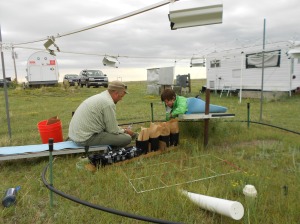
Event: Good times had by all at seventh annual PHACE harvest!
by Julie Kray
Picture this: a vast field of native Wyoming grassland dotted with 10 or 12 people lying on wooden platforms a foot above the ground, slowly clipping grasses and forbs a few leaves at a time with small scissors. You may be thinking, “Who are these people, and haven’t they heard of a lawnmower? Who could be so deranged, to cut large swaths of grassland by hand?”

These people, screwy as they sound, are the scientists at work on the PHACE (Prairie Heating and CO2 Enrichment) experiment near Cheyenne, WY, and their goal is to measure how the many different plant species in this grassland are responding to elevated temperature and atmospheric CO2 levels predicted for later this century. One of the best assessments of how plants will fare under these future conditions is simply to measure their total above-ground growth. Every year at the peak of the growing season in mid-July the plants are clipped and carefully separated by species, and later dried in ovens and weighed to determine the mass each species produced (also called “biomass”). In each of the 30 experimental plots, a 0.75 m2 (8 ft2) area is harvested. The annual harvest typically takes 4-5 long, hot July days, and as many volunteers as harvest organizer Dan LeCain can enlist. How does he keep attendance and morale high, day after day?
“Scheduled cookie and donut breaks are the secret to my success.”

One might assume that clipping plant leaves is fairly uneventful, but there are numerous perils and pitfalls. Karen Burke, a lefty, admitted, “I’m not the most coordinated with sharp knives and scissors, and I kept clipping myself.” “Yeah, I was bleeding all over the plants at times, too,” Julia Pendergrass recalled.

Nicole McDaniel and Katie Dirsmith described close encounters of another kind: “Some of the plots we clipped were teeming with ants. There were the small, black ants, which were friendly… but then there were the ANGRY red ants. The ANGRY ants would rear up on their back 4 legs and jump on you and just start biting! Plot 25 was the worst!” Katie added: “We tried everything, and they would not leave us alone! First we tried wearing gloves to protect our hands, but they crawled inside the gloves and bit even harder… then we offered them a pile of peanut butter as a distraction, but it did not work—they kept attacking! All we could do was clip and pluck the plants away as fast as possible. It certainly made clipping more epic!”

Working around the experimental infrastructure at PHACE takes a bit of practice, as well as flexibility and endurance. Project leader Jack Morgan has learned that “remembering to turn off the plot heaters during harvest week so that clipping personnel are not broiled is essential. It’s also important to stay limber so that you can contort yourself into just the right position, delicately poised on a wooden platform, hanging inches above the coveted plant, all while not stepping on the numerous plant and soil sensing devices, or interfering with fellow clippers.”

Invariably, sensors are moved and some destroyed in this annual exercise, requiring a very good-natured technician, David Smith, to later repair clipped wires and restore bumped instruments. David remarks: “Two weeks of fun suspended on platforms… soldering very fine thermocouples in the prone position takes patience and practice.”
This was the 7th consecutive year of plant growth measurements at PHACE, and the driest year on record since the experiment began in 2006. The official results are not yet in, but the 2012 drought appears to have magnified the soil-drying effects of warming treatments, and the water savings from higher CO2 seen in wetter years have not kept pace with plant demands for moisture. The net result: plant growth was limited for most species this year compared with wetter years, and even the more drought-tolerant native perennial grasses, including blue grama (Bouteloua gracilis), western wheatgrass (Pascopyrum smithii), and needle-and-thread (Hesperostipa comata), produced few flowers. The 2012 biomass data should offer insight into how future plant growth under predicted higher temperature and CO2 might be further influenced by drought in western grasslands.

1University of Wyoming
2USDA-ARS